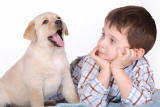If left to their own devices,
children may hurt family dogs or be
hurt, even fatally. In 2007, there
were 32 fatal dog attacks in the
USA. Dog bites are the
fifth most frequent cause of visits
to emergency rooms in the category
of activities common among children.
A 2003 Center for Disease Control
(CDC) study reported 368,000 dog
victims (1008 per day) were taken to
hospital emergency rooms. Most
victims who receive medical
attention for dog bites are
children, half of whom are bitten in
the face with boys between the ages
of 5 and 9 years seen the most.
Dr. Illana Reisner, University of
Pennsylvania, says, "Any breed - or
mix - is capable of biting…even a
perfectly nice, trustworthy, family
pet." Dr. Reisner advises parents to
never leave a newborn infant alone
with any dog, even very small dogs.
|
It is important that children
be taught and praised for all
appropriate interactions with pets, and corrected
instantly for any inappropriate interactions.
Young children should be
supervised at all times. |
 If obtaining a
new dog, the first preventive
step is to avoid any time where
the dog is alone with any child
until you have a high confidence
factor. Supervision is the key
to child safety around dogs!
If obtaining a
new dog, the first preventive
step is to avoid any time where
the dog is alone with any child
until you have a high confidence
factor. Supervision is the key
to child safety around dogs!
There are some signs to look for
that indicate a dog is becoming
stressed by a child's presence.
These signs include licking of
the lips, yawning, looking away,
acting more stiff in his or her
body postures, and attempting to
move away from the child. If the
dog has a tendency to guard
possessions or food, children
should not be allowed to be
around the dog when either
has food or toys. The food or
toys should simply be removed
from the situation. This will
likely reduce some of the tension.
Leaving the
relationships between dogs and children
to chance may lead to failed
relationships at best, and a death
sentence for the child or dog in the
worse cases. While some dogs tolerate
more than their fair share of abuse from
the normal activities of children, there
are many reasons why dogs snap and harm
children. Don't take chances, Establish
rules to keep children and dogs safe and
happy.
So, how can parents help dogs
and children to get along?
Here are four important
guidelines for teaching
children how to act and what to
do around dogs.
Preventing Dog
Bites
Set ground rules for safe play.
Children and dogs benefit from the
exercise and enjoyment of play time.
Keep play safe by insisting children
follow the rules. Rough play and dog
wrestling are against the rules. So is
running around shrieking and waving arms
wildly. Rule one, be calm and relaxed
around the dog. Rule two, stop play if
the dog gets tense or wild. Rule three,
children must start and stop games.
(This rule helps the dog to see children
in control.) Fetch is one of the best
games for children to play with dogs.
Children must start the game by asking
dogs to sit or lie down and end the game
by instructing the dog to drop or give
the ball back. Tug-of-war games are not
allowed unless the dog will sit and
release a toy immediately at any time on
cue.
Let sleeping dogs lie.
Supervise the activities of children
around dogs until you feel the child has
learned not to lung at the dog or
surprise the dog with hugs and kisses.
In general, dogs should be left alone
when they are eating and resting. Insist
on children calling the dog to them.
Show children how to offer the back of a
hand to sniff before petting a dog.
Never leave a child alone with a dog
unless you are certain both the dog and
child have learned to respond
consistently to each other.
Show
children how to train dogs.
Have children feed the dog meals instead
of leaving food out. Use feeding time as
a training time. Have children hand feed
the first 5 to 10 kibbles in exchange
for the dog following an instruction
such as sit, lie down, shake, watch,
etc. Training gives children and dogs a
structure for interacting with each
other. Stand behind the child as the
back up to insists on the dog
responding. Training with food helps
dogs to associate children with goodies.
Set the example for children by giving
the dog lots of praise for good
behavior. Encourage children to do the
same with lots of, "Good dog!"
Children walk dogs not the other way
around.
Dogs need daily physical and mental
exercise. Walking the dog away from home
provides both. Use head collars, like
the Gentle Leader, or the Easy Pull
harness to keep dogs from pulling on
leash so that children can walk dogs
with an adult near by. You want the dog
to associate the child with these fun
excursions. Bring treats along and have
part of the walks become training
activities.